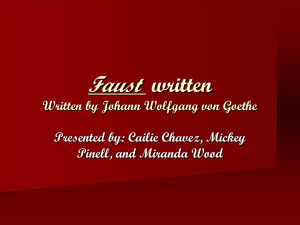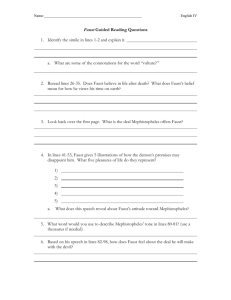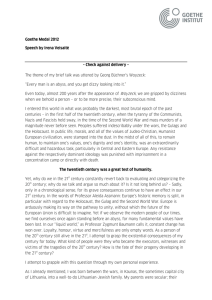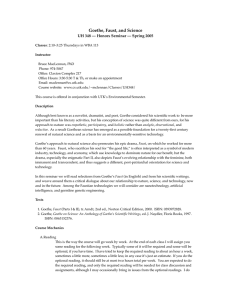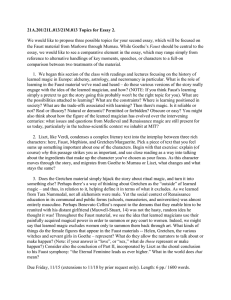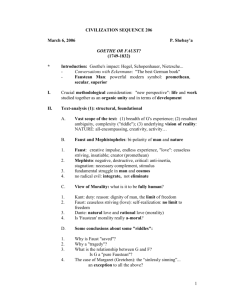Law, Literature and Justice: Exploring New Horizons
advertisement
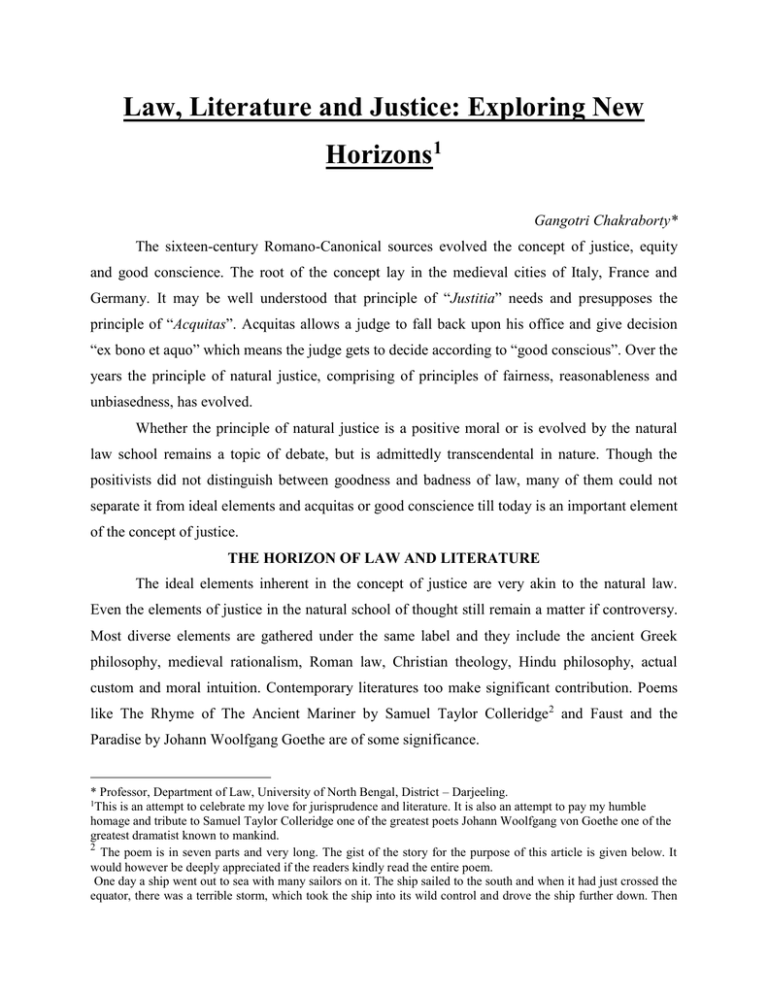
Law, Literature and Justice: Exploring New Horizons1 Gangotri Chakraborty* The sixteen-century Romano-Canonical sources evolved the concept of justice, equity and good conscience. The root of the concept lay in the medieval cities of Italy, France and Germany. It may be well understood that principle of “Justitia” needs and presupposes the principle of “Acquitas”. Acquitas allows a judge to fall back upon his office and give decision “ex bono et aquo” which means the judge gets to decide according to “good conscious”. Over the years the principle of natural justice, comprising of principles of fairness, reasonableness and unbiasedness, has evolved. Whether the principle of natural justice is a positive moral or is evolved by the natural law school remains a topic of debate, but is admittedly transcendental in nature. Though the positivists did not distinguish between goodness and badness of law, many of them could not separate it from ideal elements and acquitas or good conscience till today is an important element of the concept of justice. THE HORIZON OF LAW AND LITERATURE The ideal elements inherent in the concept of justice are very akin to the natural law. Even the elements of justice in the natural school of thought still remain a matter if controversy. Most diverse elements are gathered under the same label and they include the ancient Greek philosophy, medieval rationalism, Roman law, Christian theology, Hindu philosophy, actual custom and moral intuition. Contemporary literatures too make significant contribution. Poems like The Rhyme of The Ancient Mariner by Samuel Taylor Colleridge 2 and Faust and the Paradise by Johann Woolfgang Goethe are of some significance. * Professor, Department of Law, University of North Bengal, District – Darjeeling. 1 This is an attempt to celebrate my love for jurisprudence and literature. It is also an attempt to pay my humble homage and tribute to Samuel Taylor Colleridge one of the greatest poets Johann Woolfgang von Goethe one of the greatest dramatist known to mankind. 2 The poem is in seven parts and very long. The gist of the story for the purpose of this article is given below. It would however be deeply appreciated if the readers kindly read the entire poem. One day a ship went out to sea with many sailors on it. The ship sailed to the south and when it had just crossed the equator, there was a terrible storm, which took the ship into its wild control and drove the ship further down. Then Colleridge wrote the Rhyme in 1797-1798.The social contract approaches to natural law culminated in the writing of Rousseau during 1712-1778 and Immanuel Kant made his contribution in 1724-1804. Self-preservation is a great lesson of natural law. Social contract is a means to give effect to that desire of self-preservation. To Rousseau, social contract is a mystical construct by which the individual merges into the community and becomes part of the general will. Law is the register of the general will. Whoever refuses to obey the general will shall be compelled to do so by the whole body. According to him disobedience is morally illegitimate because it results in failure to discharge a moral obligation a citizen incurs while acting as a citizen. According to Rousseau, the general will is the moral will3. The mystical general will assume a transcendental metaphysical character. Kant reaches a conclusion similar to that of Rousseau. According to him morality and freedom are one and the same provided law is in conformity with morality. Therefore, freedom and the right to be free is not subject of any positive norm but are metaphysical and transcendental in nature. Kant tells us that the history of human race can be regarded as a realization of a hidden plan of nature to bring about an internally, and for this purpose also externally, a perfect political constitution as the only possible state with which all natural capacities of mankind can be developed completely. 4 Thus the politico-legal system so proposed is deeply rooted in moral obligations Colleridge seems to be affirming the combined wisdom of Rousseau and Kant. The action of the ancient mariner in killing the albatross against the wishes of his fellow crewmen symbolizes the action of a citizen against the general will and the subsequent plight of the mariner reflects how the general will the ship met with dense mist and snow and it became terribly cold. Icebergs as high as the mast were floating by. They were as green as the emerald. There were big icebergs all around and nothing, not even a bird or beast could be seen. There were only the loud crackling, howling roaring and growling noises that were almost deafening in intensity. The ice created an impenetrable wall and the ship came to a stand still. All the sailors were depressed and feared for their own lives. Amidst all this came an Albatross and sat on the mast of the ship. The sailors were delighted to see a bird in that cold, cloudy, and stormy weather and hailed the Albatross as a kind Christian soul, a representative of God. The bird shared the food of the sailor and it flew around the ship again and again. The ice then began to split up with thunderous noises. The passage thus created enabled the ship to pass through the wall of the ice. As the ship followed through the path thus made the Albatross began to follow the ship. Now this had become a common sight, the albatross would follow the ship as if it is its guardian angel. And like a close friend the albatross would the drop in for lunch and spend some time with the marines. Everybody thought it is a holy sight and a good omen. However the ancient mariner kills the albatross against the wishes of all his crew friends. Soon after the weather changes and the sun begins to shine. Slowly the sun becomes so hot that the crew begins to die of thirst and the albatross hangs around the mariner’s neck and it is so heavy and does not come out. Eventually, when the mariner is on the verge of death and he begins to pray and do penance. Gradually the albatross comes out from his neck and the crew comes alive. – The Rhyme of the Ancient Mariner, Samuel Taylor Colleridge. 3 M. D. A. Freeman, Lloyd’s Introduction To Jurisprudence, Sixth Edition, Sweet & Maxwell, P. 105-108. 4 H.B Nisbet, Idea for a Universal History with a Cosmopolitan Purpose in Kant’s Political Writings, (1970), P. 86. prevails through the imposition of a moral obligation forcing him to reaffirm the accepted moral standards. . It may not be out of place to recall that natural law thinkers like Saint Thomas Aquinas dominated the period from the church fathers to Kant. Aquinas divided law into four, although the concept of law remained unified as a whole. The four divisions are the lex aeterna, which is the divine reason known only to God and the blessed that see God in his essence. It is God’s plan for the universe and everything and every body is subjected to it. Lex divina is the law of God revealed in the scriptures. Lex naturalis is the participation of eternal law in rational creatures, and finally the lex humana is the law posited. Colleridge seems to be more influenced by Aquinas and yet strives to keep pace with Rousseau and Kant. The leaning towards Aquinas appears to be more prominent. On the whole Colleridge is conspicuously trying to reconcile the theories put forth by Acquinas, Rousseau and Kant when he brings about a just retaliation once by hanging the dead albatross around the neck of the ancient mariner and again and restoring status quo ante after the mariner regrets his action. In Colleredge’s view the primary component of justice is moral which is transcendental and metaphysical in nature. Although towards the later part of the eighteenth century natural law was being challenged for not been able to answer questions like how to contain the power of the sovereign? Do we obey bad laws? Are laws not rooted in morals and divinity good law? The Hindu law too also has been proposing something similar from ancient times. The “forces” of nature has been a prime preoccupation of the Hindu thought from whence arise all forces of law and justice. The manifest energy is called shakti which is symbolically represented by the cosmic feminine prakruti and the non manifest static form is purusha5. The ultimate dharma is to maintain a balance between the transcendental metaphysical cosmic world and the gross mundane physical world. It is a balance that is held at equilibrium by “Varuna” who is the symbol of justice. If the gross mundane world upsets the equilibrium, then equilibrium is restored by either ativrushti (deluge) or anavrushti (draught). Varuna is the ultimate validator of all actions.6 Colleridge’s story is uncannily similar to this school of thought. This close proximity with nature made man to observe nature very closely and formulate many jural postulates simply by observing nature. For example on one hand the natural resources 5 6 Prakruti is also the metaphysical transcendental cosmic world and purusha is the mundane physical world. This concept is very similar to Kelsen’s “grundnorm”. are there which are to be shared equally by all living creatures and on the other hand the living creatures were visibly unequal to each other. Amidst such diversifications the doctrine of equality emerged as an instrument for managing the inherent inequities of nature. The other doctrine that emerged is that if not regulated, “might” will become the right. So nature exerted both abstract and manifest influence upon the thinking of man. The abstract influence gave rise to the inner consciousness of man and the manifest influence shaped the objectivity and the rational of man. Since man could not fathom the source of inner consciousness, but found it to be present in all people, it was understood to be of divine in origin. So, if a code of conduct conformed to the inner consciousness, it was considered to have emanated from the divine. Herein lay the concept of equality, fraternity, liberty, freedom and justice. The moral order thus formulate is called the Rita. This is the “Universal Inner Consciousness”7. This is not very dissimilar to the thinking of Aquinas, Kant and Rousseau. The inherent, transcendental metaphysical moral finds a location in the heart of the concept of justice. Through the story of the mariner Colleridge endorses the contemporary emphasis on the transcendental metaphysical moral that ultimately validates all laws and is the dispenser of justice. However even this explanation could not satisfactorily answer the issues relating to containing the power of the sovereign and also how does one handle the law which is not rooted in morals. During the renaissance the very concept that knowledge originates from divine source alone was under challenge and Johann Woolfgang von Goethe’s Faust8 is a poignant discourse on the issue. Through Faust’s exploration into the mysteries of life with the help of the devil Mephistopheles and in the process his exploitation of the young virgins, Goethe seems to be 7 B. G Gokhale, Indian Thought Through Ages, (1961), Asia Publishing House, P. 23-30. The story of Faust is very long and cannot be reproduced in details. Interested readers may like to read the full text. It is available on the net. A brief version of the story relevant to the discourse at hand is produced below. The story of Faust is about Faust’s exploration into the mysteries of life. Part One opens with Mephistopheles (who is supposed to be the devil) entering into a bargain with God for the soul of Faust. Faust has struggled long for enlightenment, has studied deep, and thirsts after knowledge and understanding. God indicates that Faust serves His plan uncomprehendingly and that he will eventually be led towards the light, but He grants Mephistopheles the freedom to lead Faust astray. In the first part of the play, Faust is tricked into the pact with Mephistopheles and casting off his scholar’s gown leaves his study and his mean scholar's cell behind, to immerse him in the action of life. His lofty pursuit of knowledge and study of Philosophy, Law, Medicine, Theology and the Sciences had repressed his experience of human feelings, and when Mephistopheles allows free rein to his emotions, it emerges in an adolescent and un-integrated form. With Mephistopheles’s guile and cunning, Faust pursues the young virgin Gretchen and ultimately corrupts her and destroys her life. When asked at the end of his days as to the reason behind such behaviour Faust says that the devil (evil) can also be a source of knowledge. -Faust by Johann Woolfgang von Goethe. 8 asking the question that if the source of knowledge is not from a moral source does it not remain a knowledge, and should one ignore such a knowledge merely because it’s source happens to be immoral? Goethe directly challenges the question of morality in the source of knowledge just as the positivists have questioned the source of law and also the extent to which law should remain rooted in morals. The positivists’ separation of law from morals and the need to obey a posited law notwithstanding the issue of morality was the answer to the questions the natural school of thought could not give. However when it came to the question of validating such laws and limiting the power of the sovereign, Jeremy Bentham proposed the concept of Pacta Regalia and lex Principem in his Utilitarian theory, John Austin evolved the concept of Positive Morals in his Comman/Imperative theory, Hans Kelsen gave the concept of Grundnorm in his Pure theory of law, H.L.A. Hart the concept of Inner Morality in the Concept of law theory, Roscoe Pound spoke of Jural Postulates in the Social Engineering and Fredrick Karl Savigny came up with the concept of Volkgeist to name a very few of the thinkers9. Somewhere at the base of every thought was the inherent transcendental metaphysical force that made the law valid and as such justice binding. Even Goethe could not sustain his earlier attempt to separate knowledge from morals as can be seen in Faust-II also called Paradise10. Faust was published in 1808 after about six years of toil. 1711-1776 saw David Hume separate law from morals and rejected natural law on account of its being vague and confusing. It appears that Goethe was deeply influenced by Hume in as much that Faust separates knowledge from morals and states Knowledge is knowledge not withstanding its source. Paradise or Faust II was published in 1832. Though 1808 was not free from the Kantian influence; it can be regarded as watershed of the natural law philosophy. Jeremy Bentham (1778-1832)11 propounded the positive school of 9 While discussing the Schools no specific book is being cited as a sctudent of jurisprudence has to read large number of books to understand a school completely in addition to the original writing of the thinkers. 10 The next act takes Faust to the Emperor who is now at war. Faust, with the ever-helpful Mephistopheles, assists the Emperor and enables him to triumph over his enemy, in return for the rights of the coastline of his realm. Faust's great plan now is to extend the land out to sea, by damming up the ocean. He is frustrated by an old couple, Baucis and Philemon, who hold a cottage and chapel on strategic high ground which Faust wants to mould to his design. In the last act of Goethe's play, Faust wishes them to move from their sacred spot and Mephistopheles sends his henchmen to evict them, however, the old couple die in the struggle and the house is burned to the ground. In his final hours he tries to press on with his great scheme to drain the marshes and establish a great paradise on Earth won from the ocean bed, where he believes humanity through struggling against the forces of nature will become free. Ironically, Mephistopheles leads the dying Faust to believe his workmen are completing his life's work, when they are actually digging his grave. Faust dies believing that his plan was nearing fruition. 11 Bentham and Goethe were born in the same year in 1749. thought. He introduced the principle of utility in law in which the quantity of pain and pleasure could be measured. In paradise (Faust-II), Faust acquires great pleasure for the greatest number of people at the cost of pain to the few12 and the degree of pain so inflicted are preventive in nature that restrain the people from going against the wishes of the authority. However, Bentham has contemplated four sanctions; action taken by the will of people politically inferior or not in a position of authority is called moral sanction. This is again reflected in Faust-II when the people reject the idea of development by Faust and begin to dig his grave. Thus Bentham had successfully removed moral from legislation but not from the legal system similarly Goethe removes moral from source of knowledge but moral operates in the application of the application of the knowledge. Literature is said to be the mirror of contemporary society and Goethe seems to reflect the contemporary social contemplation. T.S Elliot published his much acclaimed drama Murder in the Cathedral13 in 1935, in which he wrote about the murder of ArchBishop of Canterbury Thomas Becket sometime in 1162 - 1170. When one stands on the crest of Elliot’s achievement one sees that a man, who was so agnostic in nature and an avowed positivist, raises the issue of morality in justice by sharply bringing into focus the command ( even if perceived) of the sovereign devoid of moral just as Goethe did in case of Faust-II. Historically at the bottom of the conflict between the church and the King during 1162-1170 is on an issue of criminal law. At that period if a cleric committed murder he was tried in the church and merely defrocked, whereas when a lay person committed murder he was to be hanged. The King felt that the cleric went virtually unpunished for murder whereas the lay suffered severely. In order to cure such discrimination, the King wanted a secular law for all wherein the clergy and the lay would be treated alike. The Church opposed the move on the ground that this amounts to double jeopardy as the cleric will be punished twice for the same offence. It was also viewed as the Kings design to encroach upon the authority of the Church. In 1164 a specific attempt was made by King Henry – II to separate the State from the 12 The house of Baucis and Philemon is burnt down and they are killed. T. S Elliot, Murder in the Cathedral, (1968) Twelfth Edition, Oxford University Press. The drama relates to martyrdom of most famous of all English Saints, Thomas Becket who was Arch Bishop of Canterbury between years 1162 and 1170, when he was brutally murdered in his own cathedral. The assassins were four Knights acting on consonance with a half expressed wish of the King in this matter of long drawn out but not entirely straight fight between the crown and the Church on certain constitutional issues. To them Becket appeared an arrogant turbulent priest, a traitor whittling away the rightful and reasonable power of their sovereign Henry – II and his successors. To Beckett and his fellow-monks it was a spiritual conflict, an incident in the eternal struggle between the good and the evil. 13 Church when he drew up sixteen points in which the Church would have no say. This was called the “Constitution”. Becket was forced to sign the document but refused to seal it. Thereafter he went into severe penance for having signed the document by fasting and refraining to serve at the altar. Beckets protest in retrospect reminds one of the protests made by Mahatma Gandhi against the British – a combination of self denial with legal acuity. To cut a long story short, the King then frames several criminal charges against Beckett but Becket escapes to France. A reconciliation of sorts was affected in 1170, but he was murdered on the 29 December that year. In India however, positivism and moral coexisted. There is a belief that a higher law exists in the form of Dharma that alone binds both the ruler and the ruled. Composition of Dharma is Truth and Justice. In India, the concept of law, morality and religion are not watertight compartments and are complimentary to each other and they coexist together. Dharma is the true sovereign of the State and the rule of law.14 Another School of thought covers the period during which Goethe was working on Faust namely, German Historical school of thought prominently led by Fredrick Karl von Savigny (1779-1861). Forerunners of Savigny were Schelling and Hugo who rejected Natural law in favour of historical perception of law, which evolves according to the genius, tradition, and sentiment of people. Savigny took the thought further and gave it the shape of volkgeist. It would appear that Faust was a contributor to the formation of that volkgeist. In India the true spirit or the geist is Dharma. Shorn of symbolism, formalism and ritualism the Indian geist represents the eternal human quest for dharma (truth and justice), vidya (Knowledge). The King was bound by dharma and in his role as judge he merely declared Dharma and never made it. Knowledgeable persons, commonly known as sages, interpreted Dharma. The king was bound by strong public opinion. Mahavira the founder of Jainism expounded three basic rules of Dharma viz. right path, right knowledge and right conduct. Buddha included four noble truths and eightfold path of discipline in his concept of dharma. Dharma transcends all dogmas, blind cults and practices and includes truth, righteousness, justice, freedom equality, harmony and tolerance within it. 14 S. N Dhyani, Fundamentals of Jurisprudence, Indian Approach, Central Law agency, P. 94-100; 205-208. The concept of Rita and Dharma has been given a strong recognition by Paolo Coelho15. The Brazilian writer Paolo has consistently celebrated the transcendental metaphysical higher norm in all his writings since 1987 over a period of twenty years when the modern legal world was also recognizing the transcendental metaphysical values in the concept of justice. Dr. A.P.J Abdul Kalam16 who is perhaps one of the most celebrated thinker of modern India has also celebrated this transcendental metaphysical values in the concept of justice. According to him universal power is neither judgmental nor critical but only accepts something for its own value. Appreciating emperor Ashoka’s philosophy, Kalam advocates State morality and private morality. The former according to him makes the society just and fair and the latter makes the individual life just and fair. Now the national geist is reflected in the Constitution of India as equality, fraternity, liberty, socialism, secularism and more recently fairness. These concepts are not to be conceded by any socio-political or Politico-geographical entities but are to be adopted and assimilated by them as part of the justice delivery system and as such these norms are transcendental and metaphysical in nature. The question of fairness is behind every quest of justice. The ancient mariner and Faust at the end of their respective stories do leave behind issues of fairness, which may or may not satisfy the reader. However over the interceding centuries issues of fairness has been a major preoccupation the literati like Paolo Coelho and Kalam and also of legal scholars. This is not to suggest that this is the only type of thought that goes on in the world of literature and law. This is merely an attempt to show that literature and law influence each other in a profound manner. EXPLORING THE HORIZON OF JUSTICE John Rawls17 (1971) has explored the concept of justice as fairness. According to Rawls the basic subject of justice is the way in which the social institutions distribute fundamental rights and duties and the way it determines division of advantages from social cooperation. Legal protection of freedom of thought, liberty of conscience, competitive market and private property 15 Palo Coelho,The Pilgrimage, (1987) Editora Rocca Ltd, English version in 1992, The Alchemist, (1988) Editora Rocca Ltd, English Edition in1993;The Fifth Mountain, (1998), Harper Collins Ltd.; Veronica Decides To Die, (2000), Harper Collins Ltd. The Zahir,(2005), Harper Collins; 16 Dr. A.P.J Abdul Kalam with Arun K Tiwari, Guiding Souls, (2005), Ocean Books Pvt. Ltd. 17 John Rawls, A Theory of Justice, (2000), Universal Law Publishing Co. Pvt. Ltd. etc are social institutions referred to by Rawls18. This basic structure is the subject matter of justice because its effects are profound. The two principles of justice identified by Rawls are: 1. Each person is to have an equal right to the most extensive basic liberty compatible with a similar liberty with others. 2. Social and economic inequalities are to be arranged so that they are both within a reasonably expecteda) To be to every one’s advantage, and b) Attached to positions and offices opened to all. The impartial and consistent administration of laws and institutions, whatever their substantive principles, may be called formal justice. If one thinks of justice as always expressing a kind of equality, then formal justice requires that in their administration laws and institutions should apply equally ( that is, in the same way) to those belonging to the classes defined by them. The main ideas is that when a number of persons engage in a mutually advantageous cooperative venture according to rules and thus restrict their liberty in ways necessary to yield advantages for all, those who have submitted to these restrictions have a right to a similar acquiescence on the part of those who benefited from their submissions. One cannot gain from the cooperative labours of others without doing ones fair share. The two principles of justice define what is “fair” in the case of institutions belonging to the basic structure and each person receives a fair share when all (himself included) do their part. Thus by definition, the requirements specified by the principle of fairness are the obligations. The principle of fairness has two parts, the first which states that the institutions or practices in question must be just, the second which characterises the requisite voluntary acts. By the principle of fairness it is not possible to be bound to unjust institutions, or at least to institutions which exceeds the limits of tolerable injustice (so far unidentified). Without our conflating all persons into one but recognising them as distinct and separate it enables one to be impartial, even between persons who are not contemporaries but who belong to many generations Thus to see one’s place in society from the perspective of this position is to see it sub specie aeternitatis: i.e. to regard the human situation not only from all social but also from all temporal points of view. The perspective of eternity is not a perspective from a certain place beyond the world and not from the point view of a transcendent being, rather it is from the thought and feeling that the rational 18 Id at pages 11-15 persons can adapt within the world and having done so, they can, whatever their generation, bring together into one scheme all individual perspectives and arrive together as regulative principles and can be affirmed by everyone as they lives by them, each from his stand point. Purity of heart, if one can attain it, would be to see clearly and to act with grace and self command from this point of view.19 Thus what is celebrated as metaphysical and transcendental from the eighteenth and nineteenth century is concretized in the twentieth century as temporal and transcendental but as regulative principles affirmed by every one as they live by it. In the century where the positive thought, thought divided into various schools and fragmented into many theories, reigns supreme, the common law countries have concerned themselves overtly with locating moral either transcendentally or as a regulative force in the concept of justice. The concern is well reflected in the literary pieces discussed above. It has decidedly led to revival of natural law. In India the concept of justice lies anchored in the Preamble of the Constitution. The concept of fairness lies at the heart of the concept of justice. The journey from A.K Gopalan20 to Maneka Gandhi 21 has been an eventful one22. The concept of fairness has now emerged as a corner stone for the concept of justice in India. Article 21 of the Constitution of India read with Articles 14 and 19 has been the gold mine for providing a shield on moral humanitarian and constitutional grounds against arbitrary state action. Law and literature have always influenced each other. Public opinion is often the foundation in the making of a law. The people hold the ultimate power of validating a law and literature is the dialogue between the State and the people. 19 Id at pages 58, 111-114, 255,405, 416, 587. A.K. Gopalan v. State of Madras, AIR 1950 SC 127. 21 Maneka Gandhi v. Union of India, AIR 1978 SC 597 22 After emergency several books were published reflecting the people’s opinion on it. For exampleD. R Mankekar and Kamala Mankekar, Decline and fall of Indira Gandhi, June 1977, Vision Books; Kuldip Nayar, The Judgement : Inside Story of the Emergency in India, June 1977, Vikas Publishing House Pvt. Ltd. 20
